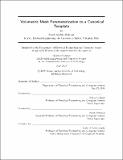| dc.contributor.advisor | Polina Golland and Justin Solomon. | en_US |
| dc.contributor.author | Abulnaga, Sayed Mazdak | en_US |
| dc.contributor.other | Massachusetts Institute of Technology. Department of Electrical Engineering and Computer Science. | en_US |
| dc.date.accessioned | 2018-09-17T14:50:20Z | |
| dc.date.available | 2018-09-17T14:50:20Z | |
| dc.date.copyright | 2018 | en_US |
| dc.date.issued | 2018 | en_US |
| dc.identifier.uri | http://hdl.handle.net/1721.1/117804 | |
| dc.description | Thesis: S.M., Massachusetts Institute of Technology, Department of Electrical Engineering and Computer Science, 2018. | en_US |
| dc.description | This electronic version was submitted by the student author. The certified thesis is available in the Institute Archives and Special Collections. | en_US |
| dc.description | Cataloged from student-submitted PDF version of thesis. | en_US |
| dc.description | Includes bibliographical references (pages 63-68). | en_US |
| dc.description.abstract | We present a volumetric mesh-based algorithm for mapping the placenta to a canonical template to enable effective visualization of local anatomy and function. Monitoring placental function in vivo promises to support pregnancy assessment and to improve care outcomes. We aim to alleviate visualization and interpretation challenges presented by the shape of the placenta when it is attached to the curved uterine wall. We flatten a volumetric mesh that captures placental shape to resemble the well-studied ex vivo shape. We formulate our method as finding a piecewise affine map from the in vivo shape to an ellipsoidal or a cylindrical template while minimizing the symmetric Dirichlet energy to control distortion throughout the volume. Local injectivity is enforced via constrained line search during gradient descent. We evaluate the proposed method in the context of a twin pregnancy study that includes MRI scans of seven women. We achieve sub-voxel accuracy in mapping the boundary of the placenta to the template, while successfully controlling distortion. We demonstrate that our approach enhances visualization of the placental anatomy and is generalizable to map to a number of canonical templates. | en_US |
| dc.description.statementofresponsibility | by Sayed Mazdak Abulnaga. | en_US |
| dc.format.extent | 68 pages | en_US |
| dc.language.iso | eng | en_US |
| dc.publisher | Massachusetts Institute of Technology | en_US |
| dc.rights | MIT theses are protected by copyright. They may be viewed, downloaded, or printed from this source but further reproduction or distribution in any format is prohibited without written permission. | en_US |
| dc.rights.uri | http://dspace.mit.edu/handle/1721.1/7582 | en_US |
| dc.subject | Electrical Engineering and Computer Science. | en_US |
| dc.title | Volumetric mesh parameterization to a canonical template | en_US |
| dc.type | Thesis | en_US |
| dc.description.degree | S.M. | en_US |
| dc.contributor.department | Massachusetts Institute of Technology. Department of Electrical Engineering and Computer Science | |
| dc.identifier.oclc | 1051458584 | en_US |
